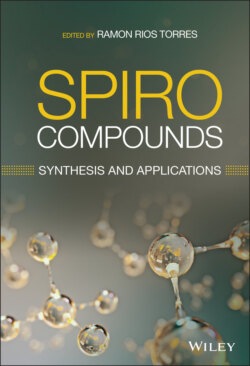Читать книгу Spiro Compounds - Группа авторов - Страница 28
3.3.2 Organocatalytic [4+2] Cycloaddition Strategies to Construct Spiro Compounds
ОглавлениеIn 2016, Jørgensen and coworkers reported the asymmetric synthesis of spiroindenes 182 containing up to four contiguous stereocenters via trienamine catalysis (Scheme 3.17) [29]. The reaction between benzofulvenes 183 and 2,4‐dienals 184 catalyzed by the diphenylprolinol silyl ether catalyst 138 and ortho‐fluorobenzoic acid (o‐FBA) as additive furnish the indenes spiro‐fused to cyclohexene compounds 182 through a formal [4+2] cycloaddition. A range of differently substituted spiroindene compounds was formed efficiently in high yields (66–98%) and excellent stereoselectivities (6 : 1–>20 : 1 dr and 79–99% ee). The authors proposed that the all‐E‐configured trienamine intermediate reacts with the benzofulvene via an endo transition state where charge stabilization between the nitrile group and the enamine moiety could be a significant factor for the catalytic performance and the observed stereoselectivity. Finally, the Michael acceptor present in products 182 was demonstrated to facilitate further intramolecular cyclizations to yield complex polycyclic products. Thus, reduction of the aldehyde moiety to the alcohol or reductive amination with benzylamine triggered the intramolecular oxa‐ or aza‐Michael additions to yield the tetracyclic spirocompounds 192 and 193 as a single diastereoisomer in 58 and 54% yield, respectively.
The same group reported the first asymmetric organocatalyzed [4+2]‐cycloaddition reaction via a tetraenamine intermediate 194a–b for the construction of highly functionalized spirocyclic oxindoles 195 (Scheme 3.18) [30]. The reaction between 2‐(cyclohepta‐1,3,5‐trien‐1‐yl)acetaldehyde 196 and 3‐alkyliden oxindoles 197 in the presence of diphenylprolinol silyl ether catalyst 198 forms a wide range of spiranic products in high stereoselectivities (86 : 14–>95 : 5 dr and 68–95% ee) containing a highly functionalized six‐membered ring with an annulated seven‐membered ring. Mechanistic investigations suggested a stepwise mechanism via tetraenamine formation, conjugate addition, catalyst hydrolysis, and a final cyclization/isomerization sequence. Although the s‐trans conformer of the nucleophilic enamine 194a was detected by NMR spectroscopy, the authors proposed that the reactive intermediate is the enamine 194b, based on computational studies as well as the stereochemical outcome of the reaction.
Scheme 3.17 Stereoselective synthesis of spiroindene via trienamine catalysis with benzofulvenes.
Source: Modified from Donslund et al. [29].
In 2014, Connon and coworkers developed the first catalytic asymmetric Tamura [4+2] cycloaddition reaction for the construction of spiro compounds 206 (Scheme 3.19) [31]. Alkylidene oxindoles 203 react with enolizable anhydrides 204 by means of a quinine‐derived squaramide bifunctional catalyst 205 to generate the densely functionalized spirooxindoles 206 bearing three contiguous stereocenters with excellent enantiocontrol (89%–>99% ee). The methodology tolerates a wide range of enolizable anhydrides and alkylidene oxindoles with different stereoelectronic requirements. Interestingly, using 20 mol% of the organocatalyst at −50 °C, the kinetic diastereomer 213 can be isolated in 98% ee. Thus, by simply changing the reaction temperature is possible to switch the stereoselectivity of the process, an important approach in target‐oriented synthesis.
Scheme 3.18 Organocatalytic [4+2] addition reactions via tetraenamine intermediate.
Source: Modified from Stiller et al. [30].
In 2017, Yang and coworkers designed a sulphonamide‐based H‐bond donor organocatalyst derived from L‐pyroglutamic acid, a cheap chiral feedstock available in both enantiomeric forms (Scheme 3.20) [32]. The catalyst 214 was successfully implemented in the [4+2] cyclization between methyleneindolinones 15 and 2‐vinyl‐1H‐indoles 215 to assemble carbazolespirooxindoles 216 in excellent yields (62–99%) and stereoselectivities (81–>99% ee, >20 : 1 dr). The methodology has a broad tolerance to structural changes in both substrates (25 examples). Control experiments suggest that N−H groups in both substrates actively interact with the organocatalyst 214, having sizable influence on the observed enantioselectivity (Scheme 3.20). Moreover, water plays a critical role in the enantioselectivity via an H2O‐relay H‐bond between the catalyst and the 2‐vinyl‐1H‐indole.
Scheme 3.19 Chiral H‐bond donor‐catalyzed asymmetric Tamura [4+2]‐cycloaddition.
Source: Modified from Manoni and Connon [31].
